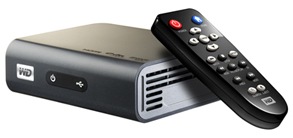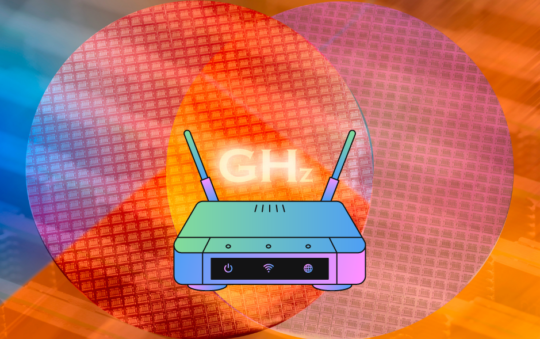Author: Sean Michael Kerner
Review Date: 10/19/2010

Product Name/Model: WD TV Live Plus
Price: $149
Pros: Support for Windows 7 Play To, Netflix, Ethernet and USB 2.0 connected devices
Cons: slow startup, no support for Hulu, iTunes or Amazon Unbox.
In the last couple of years a flood of media player devices have hit the market. The goal of the media player is to enable consumers to bring their PC and online media content to their living room television sets. The WD TV Live Plus is the newest such device from Western Digital, a vendor perhaps best known for its hard drive and storage technologies. With the WD TV Live Plus, Western Digital is delivering a device that streams a wide array of content to HDTVs including Netflix and YouTube as well as media from network attached and USB storage.
The Device
The WD TV Live Plus is a small device, measuring 1.57″(H) x 3.94″(D) x 4.94″(W), weighing in at 0.67 pounds (yeah, it’s small). There are two USB 2.0 ports (one front, one side), composite A/V (RCA), component video, HDMI and a 100 Mbps Ethernet port. There is no fan, just two exhaust vents on the sides of the device. Yes, this box can get a little bit hot, but it’s silent.
There is no on/off switch for the device: The included remote control is the only way (short of unplugging the unit) to turn it on or off. The remote handles all the media operations, providing the usual forward/back and play/pause buttons.
Digging into the underlying operating system internals, Western Digital doesn’t detail much in the user manual, but does give us a hint with a sentence that notes that the device includes open source software. The company also provides a link to its GPL code download location. Code licensed under the GPL is open source code that requires vendors to make it available to all users. A quick look at the WD’s GPL code reveals that the WD TV Live Plus runs a Linux 2.6.22.19 kernel as the underlying embedded operating system.
Setup
Getting the WD TV Live Plus set up is a simple matter of plugging it into the TV, network and/or USB devices. For the TV connection, the box doesn’t include an actual HDMI cable, though it has the HDMI port (so you’ll need to buy your own). It does include both composite (RCA) and component cables for standard definition connectivity.
On device power-up, the WD TV Live Plus is no speed demon. It took, on average, 49 seconds from the time the power was turned on until the device was actually usable. The WD logo doesn’t appear until approximately 5 seconds after power-on, and surprisingly the screen that says ‘loading’ doesn’t appear until nearly 45 seconds after power-on.
Content and Connectivity
Getting content onto the TV screen is all about connectivity, and the WD TV Live Plus offers a whole lot of choices. The user interface provides access to video, music, photos and what Western Digital calls ‘Internet Media’. That last title is a confusing misnomer since the Video menu also provides access to Internet media including Netflix and YouTube. The Music menu provides access to Internet media including the Live365 and Pandora online music services, and the Photo menu provides access to Flickr. The Internet Media menu only provides access to Mediafly.com which syndicates various video and audio podcasts.
No, the WD TV Live Plus doesn’t provide access to iTunes, Amazon or Hulu, which is a major shortcoming. Much of the great network TV content that is available online is available through one of those three services. So if you’re looking for the best device for viewing online media content, look elsewhere, Mediafly and YouTube alone just don’t cut it.
On the other hand, if you’ve got your own local content, that’s where the WD TV Live Plus really shines. Each menu provides a sub-menu item for USB, network shares and media servers. Going a step further, if you’ve got a Windows 7 PC, the Windows Media Play To feature enables you to stream media from the PC to the WD TV HD Live Plus and onto the TV. It’s a feature that worked flawlessly even in limited testing on a low-end Windows 7 Starter Netbook with only 1 GB of RAM – you don’t need an Intel Core i7 to make this work.
USB connectivity is dead simple – it’s just plug-and-play. On the resource CD that WD includes with the device, there is a tool called WD Discovery. The tool enables users to view USB devices connected to the WD TV HD Live Plus, create a shortcut and map the connected drives. That’s a great tool to have if you’re connecting a USB WD storage device (or any type of USB external storage) providing an easy way to move and copy content.
On the other hand, Ethernet-connected file share connections are not quite as seamless as they should be. The settings menu on the WD TV Live Plus does not include a global setting for a user to store the username/password required to access a particular network file share. Instead, the only option in the settings menu is to remember or delete the username/password (that you can’t enter on the Global Settings screen)and to enable automatic login. The actual username/password entry is done on the Video->Network shares screen. The automatic login feature was also inconsistent, and didn’t always work.
Media Formats and Playback
Once connected to whatever media source you want, media playback on the WD TV Live Plus is very good, providing up to full 1080p of resolution.
In terms of media support:
On the audio side, the device handles MP3, WAV/PCM/LPCM, WMA, AAC, FLAC, MKA, AIF/AIFF and OGG.
Video support includes AVI (Xvid, AVC, MPEG1/2/4), MPG/MPEG, VOB, MKV (h.264, x.264, AVC, MPEG1/2/4, VC-1), TS/TP/M2T (MPEG1/2/4, AVC, VC-1), MP4/MOV (MPEG4, h.264), M2TS and WMV9. The WD TV HD Live Plus does not support WMAPro audio codecs, which could be an issue for some use-cases.
In limited testing, a small number of AVI and WMV files did not play on the device, likely due to codec incompatibility. From the user perspective, AVI and WMV are video container formats and the device display does not identify the codecs used. Unlike a PC experience, where the user’s media player might identify the missing codec and enable a download, the WD TV Live Plus doesn’t have that option. So if the media isn’t encoded with a supported codec, you’re out of luck.
The Bottom Line
The WD TV Live Plus is an excellent network media player for most types of local network content. Over the course of several weeks of use, the device performed well, playing nearly everything that was thrown at it. The slow startup time is a small annoyance, since most of us expect TV-connected equipment to have instant-on capability. The lack of full online media connectivity from the major TV networks, which are available on Hulu and Amazon, is another shortcoming if you’re looking for that type of content.
If you’ve got your own content archive, or are looking to build one with some network or USB attached storage, this device will make a lot of sense. Sure, you can get online and local network content onto your TV via your PC (and if you’ve got an HDMI connection, more power to you), but at a list price of $149, this device is likely cheaper and a whole lot easier to use than trying to use some form of connected media PC.




